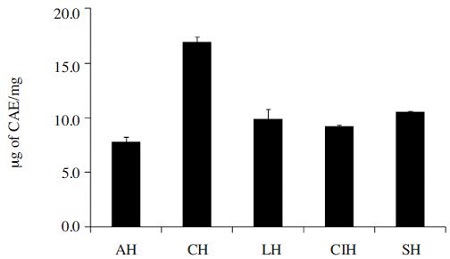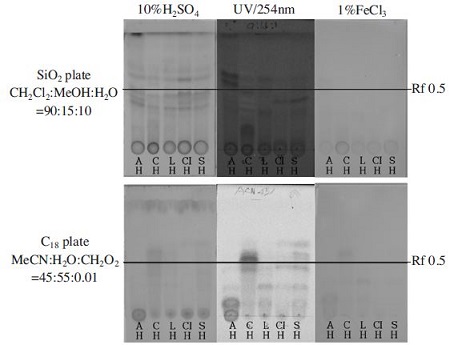
Comparison of Anti-oxidant Activity of Ethyl Acetate Extracts of Different Floral Honeys from Korea
Abstract
This study was done to compare anti-oxidant capacity of honeys from different floral sources (acacia, chestnut, linden, citrus and styrax). The ethyl acetate extracts of individual honey samples were taken to measure the anti-oxidant activity and total phenolic content (TPC) by 2,2-diphenyl-1-picryhydrazyl (DPPH) free radical scavenging assay, and Folin-Ciocalteu's assay respectively. The ethyl acetate extract of chestnut honey at the concentration of 1mg/mL showed the highest free radical scavenging activity of 45%. Its TPC which was found to be 17μg GAE/mg, was also the highest value compared to that of other honey extracts. The study results indicate that phenolic compounds in honey are the major constituents to contribute for their antioxidant activity.
Keywords:
Korean honeys, Anti-oxidant activity, Total phenolic contentINTRODUCTION
Floral honey, a natural sweetener collected by bees from nectar, is a complex mixture of sucrose, fructose, glucose, water, proteins, amino acids, vitamins, minerals and organic acids, and widely used as supplementary diets, tonics, cosmetics and so on (Chang et al., 1988; Burlando and Cornara, 2013). It also has been reported to have various biological activities as anti-oxidant, antiinflammatory and anti-bacterial agents (Yaghoobi et al., 2013). Since, the classification of honey is based on their floral sources such as acacia, chestnut, astragalus, heather, clover, lavender, oak etc and there has been hundreds of types of honey found globally (Can et al., 2015). Monofloral honeys show significant difference of chemical composition, taste, scent, color and purpose of use in accordance with floral origin (Ozcan and Olmez, 2014). Typically, manuka (Leptospermum scoparium) honey produced in New Zealand is used as material for wound dressing, and is sold as pharmaceuticals in USA and Europe, and is known as an effective therapeutic agent for severe burns. (Lusby et al., 2002). Heather (Calluna vulgaris) and lavender (Lavandula stoeclias) honeys, which contained constituents such as phenolic compounds from nectar, are known to have anti-oxidant activity (Can et al., 2015). Thus, honey possesses different biological activities which are affected greatly by secondary metabolites and enzymes from floral origin. In present study, we determined the antioxidant activity and phenolic content of five different monofloral honeys (acacia, chestnut, linden, citrus and styrax honeys) from Korea and analyzed the relationship between total phenolic contents and the antioxidant activity of each type of honey.
MATERIALS AND METHODS
Honey samples
Acacia honey from Robinia pseudoacacia, chestnut honey from Castanea crenata, linden honey from Tilia amurensis, citrus honey from Citrus unshiu and styrax honey from Styrax japonica produced in 2014 were obtained from Korea Apicultural Agriculture Cooperative(Seoul, Korea).
Extraction
500g of each five honey sample was extracted with ethyl acetate (EA, SK chemicals, Seongnam, Korea) using hand mixer in water bath of 60°C for 5 min and then supernatant was evaporated in vacuo to give the ethyl acetate extract. Yield of 669, 960, 519, 960, and 800mg were obtained from ethyl acetate extracts of each honey sample.
DPPH assay
The antioxidant activities of samples were carried out by free radical scavenging activity test using 2,2-diphenyl-1-picryhydrazyl (DPPH, Sigma, St. Louis, MO) reagent (Hazra et al., 2010). 20μL of the samples at different concentrations (100, 500 and 1000μg/mL) were added to 180μL of a DPPH methanolic solution (200μM) and left it at room temperature in the dark. The optical density of reactive solutions was measured at 517 nm using ELISA reader (Molecular device spectramax M2e, Sunnyvale, CA). The radical scavenging activity was calculated from the formula given below.
Abs0: the absorbance of blank, Abs1: the absorbance of samples at different concentrations.
Total phenolic content
Total phenolic content (TPC) of samples was evaluated by Folin-Ciocalteu's (Sigma, St. Louis, MO) assay according to the modified method of Chun et al. (2003). Sample (1mg/mL) was vortexed with 1N Folin-Ciocalteau's reagent (1mL) and distilled water (5mL). After incubation at room temperature for 5 min, 10% Na2CO3 (1mL) solution was added. The absorbance was measured at 725 nm using ELISA reader. The TPC was presented as μg of gallic acid equivalents (GAE) in mg of sample.
Thin layer chromatography (TLC) analysis
Ethyl acetate extracts of five different honeys was subjected to TLC on SiO2 plate (Merck 5715, NJ, USA) and C18 plate (Merck 15683) using mobile phase CH2Cl2 : MeOH : H2O = 9 : 1.5 : 1 and MeCN : H2O : CH2O2 = 45 : 55 : 0.01, respectively. 10% H2SO4 and 1% FeCl3 were used for the detection of spots.
RESULTS AND DISCUSSION
Oxidative stress has been one of the major causes of different pathological conditions like Parkinson's disease, Alzheimer's disease, vascular disease and aging (Mariani et al., 2005; Okusaga, 2014). It occurs due to the production of excessive reactive oxygen species (ROS) which oxidize the intracellular constituents like lipids and proteins (Haraguchi et al., 2000). So, the antioxidants which fight against the oxidative stress are very essential for a healthy body. Many researches have been conducted on development of antioxidants from natural sources available as food. Among them honey is also an important natural food having various medicinal values. In this study we evaluated the antioxidant property of the ethyl acetate extracts of five monofloral honeys: acacia (AH), chestnut (CH), linden (LH), Citrus (CIH) and Styrax honeys (SH). Organic solvents such as methanol, ethanol, acetone and ethyl acetate are widely used for extraction of secondary metabolites of natural products like plant sources (Kim et al., 2009). Since, ethyl acetate has higher ability to effectively elute the phenolic portion than other solvents, it was used for the extraction of honeys derived from floral origin. The ethyl acetate extracts of five honeys scavenged DPPH free radicals in a dose dependent manner. The ethyl acetate extract of CH at the concentration of 1mg/mL exhibited the highest radical scavenging activity (Fig. 1).

DPPH free radical scavenging activity of ethyl acetate extracts of five different honeys from Korea. AH: acacia honey, CH: chestnut honey, LH: linden honey, CIH: citrus honey and SH: styrax honey.
Kim et al. (2010) have been reported that content of phenolic compounds in honeys has a correlation with antioxidant activity and our result followed the similar pattern. Phenolic compounds have been recognized as a natural antioxidants present in plant kingdom (Goufo and Trindade, 2014). Results in Fig. 2 showed that TPC in honey samples was highest in CH (17μg GAE/mg), and then followed by SH (10.5μg GAE/mg), CIH (9.2μg GAE/mg), LH (9.9μg GAE/mg) and AH (7.8μg GAE/mg).

Total phenolic content of ethyl acetate extracts of five different honeys from Korea. AH: acacia honey, CH: chestnut honey, LH: linden honey, CIH: citrus honey and SH: styrax honey.
Pearson correlation coefficient (R2) between antioxidant activity (at the concentrations of 100, 500 and 1,000μg/mL) and total phonolic content in honeys, measured by DPPH and Folin-Ciocalteu's assays was more than 0.97 and there was a noteworthy correlation with each other, showing that phenolic compounds were responsible for dominant antioxidant activity. TLC analysis of five different honey extracts on SiO2 and C18 TLC plates showed similar chromatogram suggesting similar chemical constituents in all of them. When TLC plates were sprayed with 10% H2SO4, several spots were detected at Rf value around 0.2-0.7. SiO2 and C18 TLC plates treated with 1% FeCl3 revealed that AH and CH had different pattern compared to other samples. Most components existed in honey samples were detected at 254 nm of UV wavelength (Fig. 3). We found that ethyl acetate extract of CH displayed a higher antioxidant activity and TPC than other honey extracts. These findings suggest that TPC in honeys may be responsible for the antioxidant property.
Acknowledgments
This work was carried out with the support of "Cooperative Research Program for Agriculture Science & Technology Development (Project No. PJ01083701)" Rural Development Administration, Republic of Korea.
LITERATURE CITED
-
Burlando, B., and L. Cornara, (2013), Honey in dermatology and skin care: a review, J. Cosmet. Dermatol, 12, p306-313.
[https://doi.org/10.1111/jocd.12058]

-
Can, Z., O. Yildiz, H. Sahin, E. Akyuz Turumtay, S. Silici, and S. Kolayli, (2015), An investigation of Turkish honeys: Their physico-chemical properties, antioxidant capacities and phenolic profiles, Food Chem, 180, p133-141.
[https://doi.org/10.1016/j.foodchem.2015.02.024]

- Chang, H.G., M.K. Han, and J.G. Kim, (1988), The chemical composition of Korean honey, Korean J. Food Sci. Technol, 20, p631-636.
-
Chun, O.K., D.O. Kim, and C.Y. Lee, (2003), Superoxide radical scavenging activity of the major polyphenols in fresh plums, J. Agric. Food Chem, 51, p8067-8072.
[https://doi.org/10.1021/jf034740d]

-
Goufo, P., and H. Trindade, (2014), Rice antioxidants: phenolic acids, flavonoids, anthocyanins, proanthocyanidins, tocopherols, tocotrienols, γ−oryzanol, and phytic acid, Food Sci. Nutr, 2, p75-104.
[https://doi.org/10.1002/fsn3.86]

-
Haraguchi, H., N. Yoshida, H. Ishikawa, Y. Tamura, K. Mizutani, and T. Kinoshita, (2000), Protection of mitochondrial functions against oxidative stresses by isoflavans from Glycyrrhiza glabra, J. Pharm. Pharmacol, 52, p219-223.
[https://doi.org/10.1211/0022357001773724]

-
Hazra, B., R. Sarkar, S. Biswas, and N. Mandal, (2010), Comparative study of the antioxidant and reactive oxygen species scavenging properties in the extracts of the fruits of Terminalia chebula, Terminalia belerica and Emblica officinalis, BMC Complement. Altern. Med, 10, p20-35.
[https://doi.org/10.1186/1472-6882-10-20]

- Kim, H.K., M.Y. Lee, I.P. Hong, Y.S. Choi, N.S. Kim, M.L. Lee, and S.C. Lee, (2010), Antioxidant and Antimicrobial Capacity of Several Monofloral Honey Correlation with Phenolic and Flavonoid Contents, Korean J. Apiculture, 25, p275-282.
- Kim, S.G., Choi, J., Park, H.J., Lee, S.M., and H.J. Jung, (2009), Anti-hyperlipidemic Effects of the Flavonoid-rich Fraction from the Methanol Extract of Orostachy japonicus in Rats, Kor. J. Pharmacogn, 40, p51-58.
-
Lusby, P. E., A. Coombes, and J. M. Wilkinson, (2002), Honey: a potent agent for wound healing?, J. Wound Ostomy Continence Nurs, 29, p295-300.
[https://doi.org/10.1097/00152192-200211000-00008]

-
Mariani, E., M. C. Polidon, A. Cherubini, and P. Mecocci, (2005), Oxidative stress in brain aging, neurodegenerative and vascular diseases: An overview, J. Chromatogr. B, 827, p65-75.
[https://doi.org/10.1016/j.jchromb.2005.04.023]

- Okusaga, O. O., (2014), Accelerated Aging in Schizophrenia Patients: The Potential Role of Oxidative Stress, Aging Dis, 5, p256-262.
-
Ozcan, M. M., and C. Olmez, (2014), Some qualitative properties of different monofloral honeys, Food Chem, 163, p212-218.
[https://doi.org/10.1016/j.foodchem.2014.04.072]

- Yaghoobi, R., A. Kazerouni, and O. Kazerouni, (2013), Evidence for Clinical Use of Honey in Wound Healing as an Anti-bacterial, Anti-inflammatory Anti-oxidant and Anti-viral Agent: A Review, Jundishapur J. Nat. Pharm. Prod, 8, p100-104.
